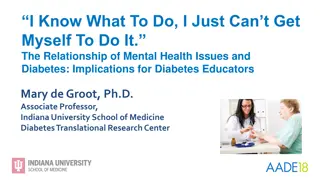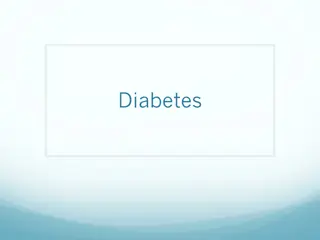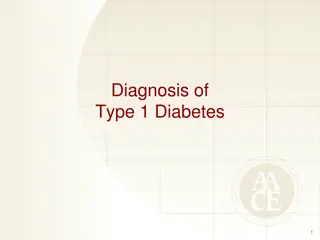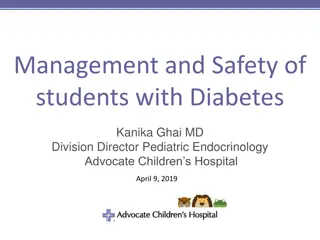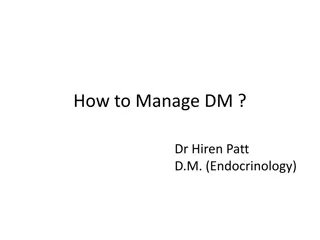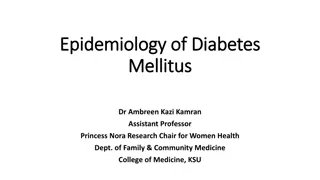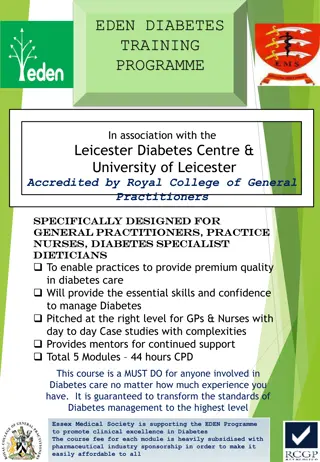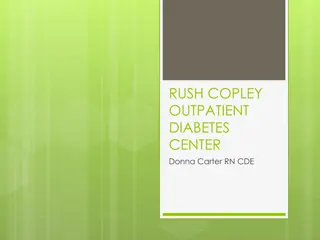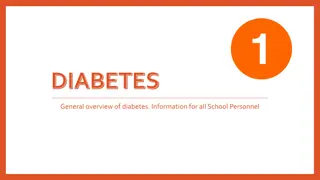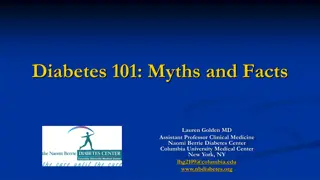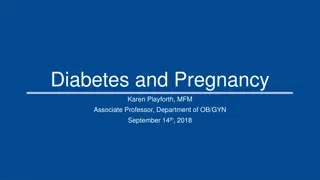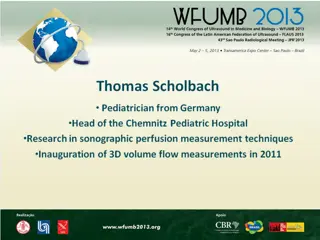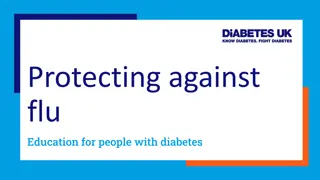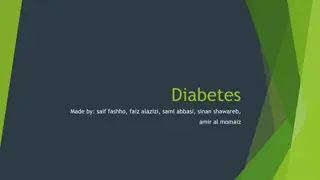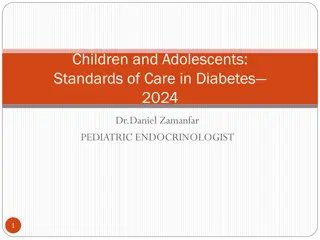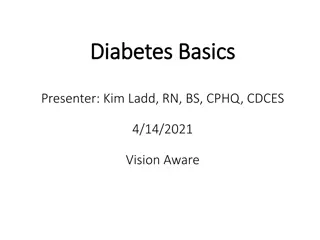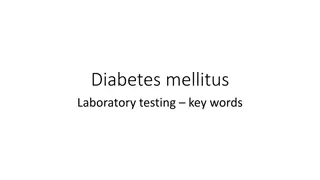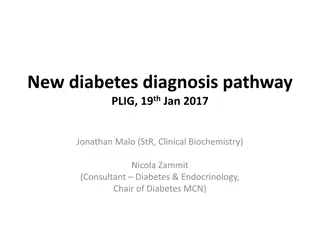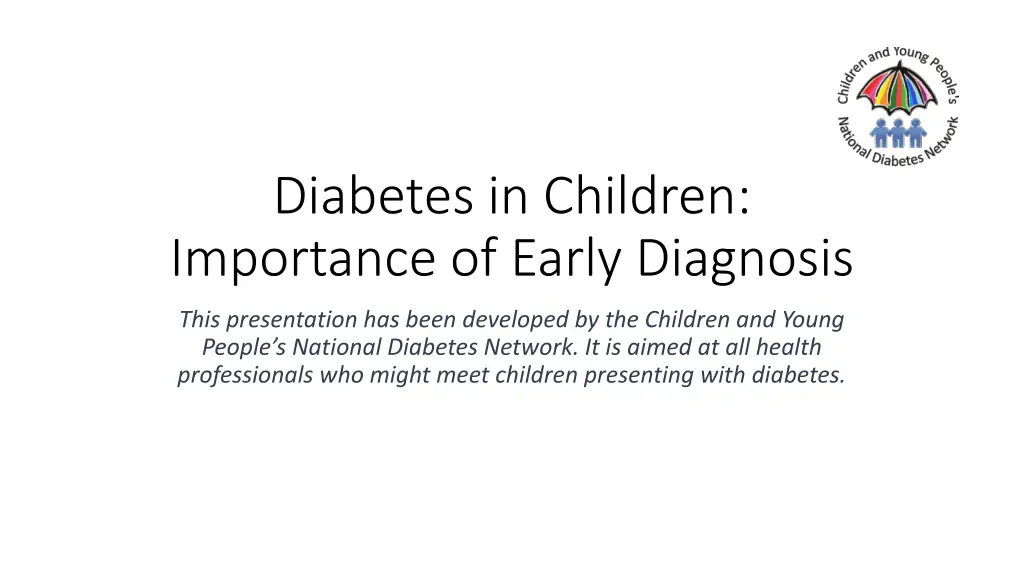
Importance of Early Diagnosis in Childhood Diabetes
Learn about the importance of early diagnosis in children with Type 1 Diabetes Mellitus to prevent complications like diabetic ketoacidosis. Understand the symptoms, development stages, and prevalence of T1D, emphasizing the need for prompt recognition and intervention by health professionals.
Download Presentation

Please find below an Image/Link to download the presentation.
The content on the website is provided AS IS for your information and personal use only. It may not be sold, licensed, or shared on other websites without obtaining consent from the author. If you encounter any issues during the download, it is possible that the publisher has removed the file from their server.
You are allowed to download the files provided on this website for personal or commercial use, subject to the condition that they are used lawfully. All files are the property of their respective owners.
The content on the website is provided AS IS for your information and personal use only. It may not be sold, licensed, or shared on other websites without obtaining consent from the author.
E N D
Presentation Transcript
Diabetes in Children: Importance of Early Diagnosis This presentation has been developed by the Children and Young People s National Diabetes Network. It is aimed at all health professionals who might meet children presenting with diabetes.
Learning Objectives What is type 1 diabetes mellitus Why is early diagnosis of type 1 diabetes important How do children present with diabetes How to recognise a child in DKA What actions to take when seeing a child with possible diabetes
What is Type 1 Diabetes (T1D) Type 1 Diabetes Mellitus is: An autoimmune condition in which immune destruction of the insulin producing cells in the pancreas leads to insulin deficiency Without insulin: There is breakdown of fat weight loss Glucose levels rise increased urination and increased thirst Glucose cannot enter cells to provide energy tiredness Accumulation of ketones diabetic ketoacidosis
How common is Type 1 Diabetes T1D affects around 34,000 children and young people in England and Wales There were 3610 new cases children in E&W in 2022/23 Incidence has been rising in recent years Source: NPDA Annual Report 2022/23
How Does Type 1 Diabetes Develop Initial trigger is not clearly understood Genetic and environmental factors are important: Children with affected relatives are more likely to develop T1D There are then 3 stages: Stage 1 diabetes auto-antibodies are detectable in the blood Stage 2 glucose levels start to rise but there are no clinical symptoms Stage 3 clinical symptoms develop Most children are diagnosed in stage 3 when clinical symptoms appear
Why is early diagnosis important T1D progresses FAST Most children have a period where there are clinical symptoms of diabetes but the child is still well This period can be months, weeks or sometimes only days If the diagnosis is not made in this period, the child becomes unwell and develops diabetic ketoacidosis (DKA) DKA is a serious condition and can be fatal
What is Diabetic Ketoacidosis (DKA) DKA is a life-threatening complication of diabetes It comprises dehydration, high glucose levels, and high ketone levels - leading to acidosis In DKA: The breathing rate rises The pulse rate rises The child feels increasingly unwell Vomiting may develop worsening the dehydration Untreated there is increasing cardiovascular collapse leading to: Shock Renal failure Coma
Question In 2019-20 in England & Wales, 2799 children under 16 were diagnosed with T1D. What percentage do you think were in DKA at diagnosis? Source: National Paediatric Diabetes Audit The answer is 38.5% That is 1078 children who could have avoided DKA if diagnosed earlier
Impact of DKA All children: Cannulation often difficult IV fluids, IV insulin Intensive monitoring Hourly blood glucose checks 4 hourly U&Es and blood gas Often need HDU sometimes ITU Can lead to: Cerebral oedema Permanent brain injury Renal failure Limb ischaemia/amputation Death Can lead to: Anxiety Post traumatic stress symptoms Traumatic and frightening experience for child and parents
Long term impacts of DKA at diagnosis Single episode of moderate/severe DKA in young children at diagnosis is associated with lower cognitive scores and altered brain growth DKA at diagnosis associated with worsened long term glucose control independent of other demographic/socioeconomic factors
Death from DKA Most children with DKA will survive with hospital treatment, but sadly some children will die from DKA. Follow the link below to watch a short video of a parent telling their story. https://www.bbc.co.uk/news/uk-wales-44808388
Question What experiences do you have of seeing a child presenting with T1D? What are the key symptoms to be aware of?
Getting Diagnosed Getting diagnosed with diabetes before the onset of DKA involves the following steps: Family recognise there is something wrong with their child Family contact health services GP practice triages urgency of appointment Health care professional suspects type 1 Health care professional tests for diabetes
Recognising T1D There are 4 key symptoms of T1D These are summarised by the Diabetes UK 4Ts campaign: Toilet Thirsty Tired Thinner
The 4Ts Toilet Passing urine more than normal Needing to wee in the night New onset bedwetting May notice sticky toilet seat/glucose crystals Thirsty Drinking a lot more than normal Needing to drink in the night May help themselves from tap in the night Babies - feeding lots Babies - excessively heavy nappies Be particularly wary of these symptoms! Children with these symptoms are at high risk of decompensating DKA
The 4Ts Thinner Weight loss may be the only initial presenting feature and often precedes osmotic symptoms May report constant hunger Parents may not notice the child has lost weight they may think they have got taller Ask if the child is looking thinner Be wary of misdiagnosing as an eating disorder Tired Tiredness is a common presentation to primary care When seeing tiredness make sure you consider diabetes Ask about the other 4Ts in your systems review
Other symptoms of T1D It is harder to recognise T1D in very young children Consider T1D in a young child with: Recurrent oral thrush Persistent nappy rash Fruity smelling breath (ketones) Constantly wants to feed Very heavy nappies Poor weight gain
Spotting DKA Children who have developed DKA may show the following additional symptoms: Tired, sleepy or confused Deep, sighing breathing Abdominal pain may present as acute abdomen Vomiting Breath that smells fruity (like pear drop sweets or nail polish remover) Be careful not to mistake the deep sighing breathing pattern of DKA for pneumonia or asthma
Making the diagnosis Diabetes must be excluded urgently in children with any symptoms of diabetes Children can progress very quickly from being well to having DKA Diagnosis is therefore made on point of care testing not lab testing The gold standard for recognising T1D is therefore: Fingerprick blood glucose test performed the same day
Fingerprick blood glucose test Make sure finger is cleaned before testing to remove any sugar Blood glucose above 11 mmol/L indicates diabetes: Transfer immediately to hospital for further assessment Lab tests will be done in hospital to confirm the diagnosis Blood glucose 7-11 mmol/L: These results are difficult to interpret Usually not T1D Discuss with on call paediatric team for further advice
Question What would stop you performing a fingerprick blood glucose test on a child? Do you have access to a fingerprick blood glucose test where you work? What would you do if it was a telephone consultation?
What about urine dipstick Urine dipstick is inferior to blood glucose test in recognising diabetes Some cases will be missed on urine testing It may not be easy to get urine sample from a child Therefore fingerprick blood glucose is the gold standard test If urine dipstick is performed and shows glycosuria Treat as T1D and discuss with on call paediatric team
Making the diagnosis Don t send for outpatient bloods to make the diagnosis Fasting glucose/HbA1c rarely required for making the diagnosis Most children with T1D and symptoms will have glucose clearly above 11.1 mmol/mol Outpatient bloods delay diagnosis and allow time for DKA to develop Don t forget about weight loss as a symptom of diabetes If arranging other tests for weight loss make sure diabetes is urgently excluded first
What about Human Factors? Why might professionals know about diabetes but miss the diagnosis? Child looks too well Children with blood glucose levels >30mmol/mol can still be well looking and running around the room Child is too young You cannot be too young to have diabetes Some infants are diagnosed before one year of age No family history While some children will have a family member affected, most children have no family history of diabetes
What about Human Factors? Why might professionals know about diabetes but miss the diagnosis? Don t believe it s diabetes It s easy to attribute symptoms to something else e.g. hot weather, medicine side effect, behavioural Do the test and don t miss the diagnosis Think diabetes is rare It s not! Over 3000 children a year are diagnosed in England & Wales Distracted by another diagnosis An infection (e.g. upper respiratory tract infection) may be a trigger for diabetes symptoms emerging. If the child has symptoms of diabetes, make sure you also do a finger prick blood glucose test.
Question What about organisational factors? If a parent contacted to arrange an appointment for a child with symptoms of T1D would your triage processes ensure a same day appointment? Do you have access to point of care blood glucose testing? Is it calibrated with testing strips that are in date?
What about Type 2 Diabetes? Type 2 diabetes is increasing in incidence in young people in the UK Clues to type 2 diabetes include: Obesity Family history of type 2 diabetes High risk group especially Asian and Black family background Clinical signs of insulin resistance i.e. acanthosis nigricans Children with type 2 diabetes can still develop DKA
What about Type 2 Diabetes? Differentiating between type 1 and type 2 diabetes is hard in children Obesity is common in children so don t assume obese children have type 2 diabetes If a child has a test result indicating diabetes, they should be discussed same day with the local paediatric team, even if type 2 diabetes is felt to be the likely diagnosis
Case 1 8 year old boy consults with 2 months of weight loss Bloods tests are normal but diabetes is not considered and not tested Consults again with 4 day history of excessive thirst and going to toilet 2 times a night Diabetes is considered and blood test for HbA1c booked for next week While awaiting blood tests child develops vomiting and drowsiness admitted in DKA pH 6.9 on admission, acute kidney injury with creatinine of 200, requires 48 hour admission to HDU
Case 1 Learning Points Always think about diabetes in a child with unexplained weight loss When suspecting diabetes do a test the SAME DAY: Finger prick blood glucose Don t send for outpatient HbA1c this will delay diagnosis
Case 2 2 year old boy consults with increased thirst Clinician considers diabetes but child looks very well, happy and playing Increased thirst attributed to hot weather 3 days later child deteriorates vomiting, pale, quiet Admitted in DKA Early into treatment develops severe headache CT shows cerebral oedema GCS deteriorates despite IV mannitol intubated and transferred to PICU
Case 2 Learning Points Children with diabetes can look very well If there is a symptom of diabetes then do a test the SAME DAY: Finger prick blood glucose Don t attribute symptoms to another cause without ruling out diabetes first
Case 3 6 year old child brought to GP with breathlessness GP notes deep sighing breathing pattern not typical of chest infection considers diabetes Further history 2 weeks of increased thirst and bedwetting Finger prick blood glucose test 30 mmol/L Transferred urgently to ED DKA confirmed IV access very difficult and has multiple cannulation attempts Develops anxiety after discharge, flashback to time in HDU, referred to team psychologist
Case 3 Learning Points Always consider DKA in a breathless child Asthma and pneumonia do not typically present with deep, sighing respiration think DKA The smell of ketones may be a clue to DKA but be aware not all people can smell these Think about diabetes in children with new onset bedwetting
Summary Remember the 4Ts of diabetes Toilet, Thirsty, Tired, Thinner Children with suspected diabetes do fingerprick blood glucose test same day Don t get caught out make sure you do the test! Blood glucose above 11mmol/L refer same day to hospital Blood glucose 7-11mmol/L discuss with paediatric team
Resources National Children & Young People s Diabetes Network www.cypdiabetesnetwork.nhs.uk/national-network/dka-prevention-at- diagnosis/ Diabetes UK www.diabetes.org.uk/The4Ts https://shop.diabetes.org.uk/products/diagnosing-type-1-diabetes-pathway- hcps NICE: Diabetes (type 1 and type 2) in Children and Young People: Diagnosis and Management www.nice.org.uk/guidance/ng18

